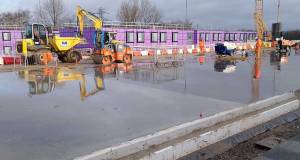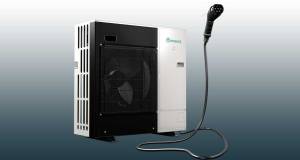
- Marketplace
- Posted
Techrete aims for net zero carbon by 2030
Leading precast concrete facade manufacturer Techrete has pledged to achieve net zero carbon emissions by 2030.
This article was originally published in issue 41 of Passive House Plus magazine. Want immediate access to all back issues and exclusive extra content? Click here to subscribe for as little as €10, or click here to receive the next issue free of charge
Leading precast concrete facade manufacturer Techrete has pledged to achieve net zero carbon emissions by 2030.
With the concrete industry responsible for circa seven per cent of global greenhouse gas emissions, the Irish company is implementing plans to quantify and reduce the environmental impacts of its products. Techrete obtained an environmental product declaration (EPD) last year for its precast concrete cladding, showing a 20 per cent reduction in embodied carbon compared to industry standards.
The company has implemented a number of sustainability initiatives which contribute to this reduction. A 250 kW PV array was installed at the company’s UK production plant in 2015, and it had a gigawatt hour (1,000,000 kWh) of electricity by 2020. A 45 kW ground source heat pump at the Dublin site was joined by a 320 kW PV array in 2021. A range of other sustainability initiatives adopted by the company include energy efficiency measures, rainwater harvesting, increasing biodiversity around the company’s sites, and the use of one hundred per cent recycled steel in their precast products, while also imposing stringent limits on cement use.
Pledging to reduce emissions by 50 per cent by 2025 and to net zero by 2030, Techrete’s plans involve using a combination of measures, including increasing the proportion of low carbon binders in concrete, reducing the volume of concrete used per square metre of façade, and developing novel low carbon concrete, before offsetting emissions that can’t be avoided, through gold standard offsets. In 2022, the company is buying 233 biomass stoves for families in developing countries.
According to Techrete’s technical director Derek Russell, the company’s products offer certain advantages which lock in carbon savings well into the next century. “Our cladding has a design life of at least 120 years, and the concrete has the ability to absorb and store CO2 via carbonation over time.” Russell adds that when the building is eventually taken down, the panels could be crushed and used as aggregates or hardcore. “The CO2 is still locked in; you reuse the concrete, and the new concrete absorbs more.”
Russell added that Techrete is increasingly getting involved in helping clients to detail an airtight, highly insulated, thermally broken façade, with the cladding having properties which can help achieve high levels of thermal performance – such as the inherent airtightness of the panels, and the development of pre-insulated panels. Mineral wool is applied in the factory under tightly controlled and audited conditions.
“We can prefit insulation into areas that maybe can’t be reached easily onsite, such as behind a core wall or a column,” said Russell.
Related items
-
 Build Homes Better updates Isoquick certification to tackle brick support challenge
Build Homes Better updates Isoquick certification to tackle brick support challenge -
 Ecological Building Systems expands UK and Irish straw panel construction with EcoCocon deal
Ecological Building Systems expands UK and Irish straw panel construction with EcoCocon deal -
 Grant’s Aerona R290: A next-gen heat pump designed for the Irish climate
Grant’s Aerona R290: A next-gen heat pump designed for the Irish climate -
 Historic Dublin building retrofitted with cutting edge insulation
Historic Dublin building retrofitted with cutting edge insulation -
 Proctor gains ground with Scottish passive schools
Proctor gains ground with Scottish passive schools -
 Heat pump and EV charger combo promises smart energy use
Heat pump and EV charger combo promises smart energy use

